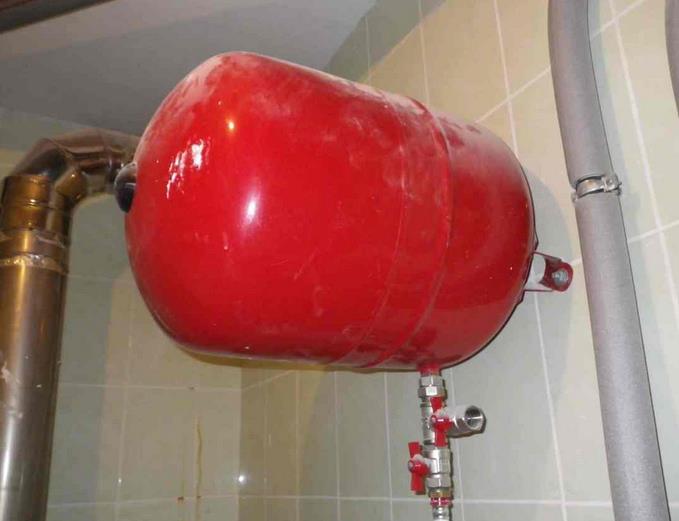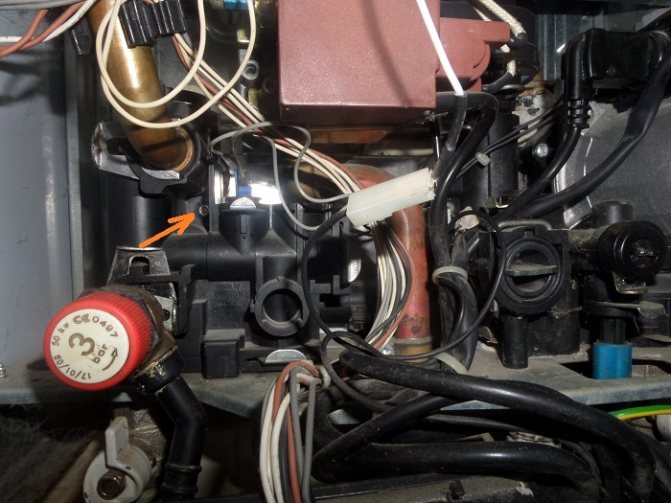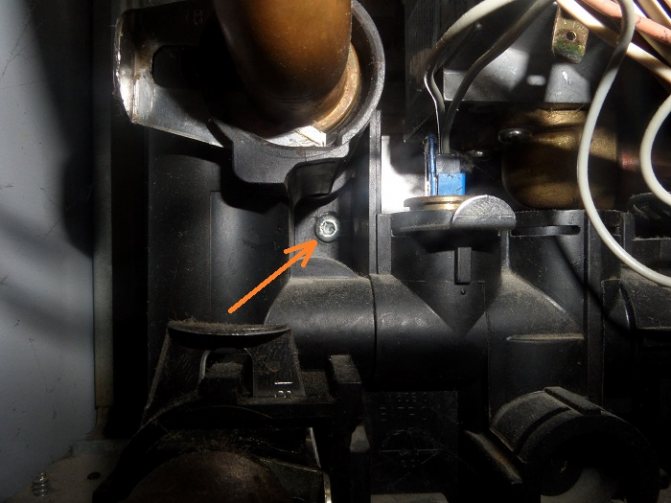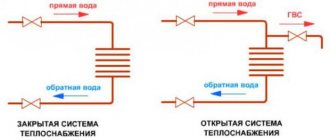The operation of water heating systems can be accompanied by the ingress of air into the inner cavity of pipes, radiators and a heat source. The appearance of an air lock leads to a change in the parameters of the coolant in individual sections or in the entire heating main. Airing the boiler can lead to overheating of the heat exchanger and failure of the heating equipment. Each user of an autonomous heating system should be able to independently get rid of congestions that arise inside the water system.
How to bleed the air from the boiler
Modern heat sources are equipped with automatic air vents or Mayevsky taps located in the upper part of the unit. Such a constructive solution allows air to be vented during operating mode without stopping the heating process of the room, just like from any radiator on which a similar valve is installed.
To do this, periodically open and close Mayevsky's tap, at intervals of several minutes. The procedure is repeated until a hiss or whistle appears, indicating the release of an airlock. The appearance of sound requires holding the bleed device in the open position until the coolant appears.
ATTENTION! The automatic air vent must remove plugs from the boiler itself when the unit is in operation. But if it is possible to bleed air from the heat exchanger after pressing the spool located under the cap of this device, then this indicates a malfunction of the air vent!
The lack of special devices for eliminating plugs on the boiler requires resorting to the help of the same devices on pipelines located above the heat source.
REFERENCE! Correctly mounted autonomous and stationary heating systems are equipped with bleed elements at the top points of the mains and next to all devices that produce or give off heat!
The ideal conditions for freeing from the air lock in the boiler is the possibility of a separate shut-off of the heat source circuit with a return pipe and a circulation pump. When turned on, the pumping of the coolant is ensured, and periodic opening of the Mayevsky valve or control over the operation of the automatic air vent, by pressing the spool, allows the closed circuit to be released from the plug.
If there is no circulation pump in the closed circuit, which cuts off the boiler with a return pipeline, then the energy source is turned on: gas, electricity, and in the solid fuel, the furnace is ignited. After heating the "supply" pipeline, the air release device is periodically opened. The heat carrier, when heated, will rise from the boiler along the main line due to heating and return through the connecting pipeline - back to the heat exchanger. This technique requires careful temperature monitoring, especially when servicing a non-solid fuel heat source. The movement of the coolant along such a circuit will be very slow and this is taken into account when performing work.
If it is not possible to shut off the boiler water circuit and there are devices for venting air only in the upper part of the line, it is necessary to drain the coolant, and then fill in the entire required volume of water. Before embarking on such global events, it is recommended to cut off all devices (except for the boiler) and, by turning on the pump, release the pressure through the nearest air vent on the line until sound or bubbles appear. The lack of a result indicates the need to completely drain the coolant.
IMPORTANT! The blockage may not form in the boiler itself, but inside the pump, which is installed in the unit body! To get rid of the air that has formed in the impeller cavity, unscrew the central pump screw by 1-1.5 turns and back until bubbles appear!
Reasons for air entering the heating system
The formation of traffic jams can be caused by various reasons, we will consider them in more detail.
- Lack of tightness of assembly joints. Especially often this reason is the initial one in the operation of systems without pressure. Small water leakage is not visible and borders on possible evaporation. In the place of a loose connection, air is sucked in and accumulates in the free cavity of the line, forming a plug.
- Inaccuracy in the design or installation of highways, which entails the creation of unwanted "loops" that inhibit the movement of the coolant, entails the accumulation of air in such circuits.
- An untechnological method of filling the system with a coolant is also the reason for the appearance of blockages. Very fast or top-down directional filling of the lines contributes to the formation of air gaps that impede normal operation.
- Malfunctioning of the automatic air vents located on the upper pipelines provokes the creation of traffic jams.
- Poor pipe installation with the formation of wavy lines (relative to the horizon) is a frequent and difficult to determine cause of the appearance of air. Elimination of this cause requires periodic removal of traffic jams, and complete elimination requires the repair of a separate section, with the possible installation of additional devices for air exhaust.
- Overheating - this reason is typical for solid fuel units. When water boils, air bubbles form in the inner cavity and accumulate in the boiler heat exchanger.
ATTENTION! It is dangerous to vent air while the boiler is boiling! There is a high risk of scalding and burns!
How air enters the circuit
There are two types of contours:
A kind of automatic air vents in an open-type heating system pass a coolant through itself, which circulates by gravity. The direction of circulation is determined by the design of the circuit. It always maintains a slope from the highest point, at the flow, to the lowest, at the return. In this case, there should be no air pockets. Air enters the heating system together with the coolant, which comes into contact with it in the expansion tank. Then it is drawn into the flow in the form of small particles, since it is impossible to bleed air from the heating system with a coolant with a temperature of 20 degrees. The hotter the water, the more intense the process of separating bubbles from the coolant. The liquid forces the bubbles upward. Accordingly, they reach a peak where they find a way out.
Since removing air from the heating is one of the key tasks for safe and efficient heating of premises, specially designed equipment is installed in the circuit.
Closed systems are hermetically sealed and circulate in them thanks to the pump. In such circuits, the flow rate is higher. They are designed in such a way that air pockets are formed in them. In this case, the installation of special equipment is required, since it is necessary to bleed air from the heating system, while maintaining its tightness. It is called an automatic air vent for the heating system. Since the system is not in contact with the environment and is hermetically sealed, oxygen can enter it only with the coolant.
In addition to the transit of oxygen by the coolant into the circuit, airing can occur:
- due to mechanical damage;
- due to repair work;
- in the event of a leak;
- after verification work.
Since it is not possible to exclude the ingress of oxygen into the system, it is necessary to make sure that it finds a way out.For this, several types of equipment are used that perform the assigned task. They can work autonomously or in manual mode.
Reasons for the formation of air congestion in the heating system
Air can enter the heating pipeline immediately in a fairly large volume, or it can accumulate gradually, but in both cases a plug forms from it, which reduces the heating efficiency in the apartment. There are sources of air entering the system that are independent of the consumer, but there are also those that can be prevented. Let's list them.
- Leakage of the pipeline, causing air to be drawn into it under the action of ejection.
- Air intake during the production of routine heating repairs.
- Defective air vents (devices for bleeding air from the system).
- Diaphragm rupture in a membrane-type expansion tank used in closed heating circuits
- Accumulation of oxygen in the system, dissolved in the incoming fresh water, especially cold water.
- Lowering the water level in the expansion tank below the permissible limit as a result of evaporation.
- Too fast filling of the system with water, when the air from the radiators does not have time to be displaced by the coolant.
- Significant pressure drops of the coolant in the central heating system, when the water from the circuit goes into the main line, where the pressure is lower.
- Central heating shutdowns with coolant withdrawal during emergency repairs of external highways.
For the formation of an air lock, in addition to the source of air intake, conditions are also needed for this:
- incorrectly executed pipeline slope;
- large spacing of the mounting brackets on the wall with a sagging span;
- malfunction of air vents or their absence.
Important! For the formation of an air lock, it is sufficient to have one of the listed ways of air intake under the action of any of the necessary conditions.
Types of equipment and how it works
- open-type expansion tank.
How to remove air from a closed-type heating system with a simple tank? It can perform the function of an air vent only in open circuits. Since it is not possible to air the closed circuit heating system using a tank. Only sealed tanks are installed in them. An open reservoir is at the peak of the circuit, where oxygen bubbles tend to. The problem is that the water is enriched with it in the same tank, so the coolant has a high level of air, which is there until the liquid is heated;
Installed at the highest point or where oxygen accumulates. The threaded portion of the heating air vent is available in two diameters: ½ ”or ¾”. In shape, they can be straight or bent at a right angle, the letter "g". The air outlet is located either at the end or on the side of the body. Works offline. Air discharge from the heating system occurs when the pressure in the system rises to a critical level. Consists of a valve and a float. The principle of operation is that when oxygen rises up, the float drops and opens the valve. As soon as the ejection has occurred, the float rises, returned to its initial position, and closes the valve;
- air separator for heating.
Placed on the serve. Unlike an automatic air vent, it does not remove the oxygen that itself separated from the coolant and rose up. The air separator in heating independently separates oxygen particles and gets rid of them. It is designed in such a way that the flow mixes, bumping into obstructions. The obstacles can be:
Air separator for heating
Aircraft elimination devices
In order to remove air from the heating system, the following devices are used:
1. Crane Mayevsky. It is arranged at the top of the radiator. In order to release the air, it is necessary to turn the valve smoothly counterclockwise with a key or screwdriver. It is necessary to turn it until a noise similar to hissing appears.

2. Automatic air vents are installed at the highest point of the heating system, as well as on the heating boiler. They are horizontal and vertical. You do not need to be present to bleed the air from the heating system. Since air vents are susceptible to contamination, it is necessary to install cleaning filters on the supply and return.


3. Air separator. Its principle of operation is to remove air that has dissolved in the heat carrier. Many separators are also designed to remove and collect sludge.


In large heating systems, only air separators are used, since it is rather difficult to remove air with ordinary hand-held devices.
What can jams in the circuit lead to?
The importance of air ducts cannot be overstated. Traffic jams in the circuit can lead to different processes:
- violation of circulation;
- pressure surges;
- decrease in the efficiency of heating equipment;
- corrosion of metal.
Stand-alone air vent
Installing an air vent in the heating system prevents the formation of plugs and pockets. Bumping into them, the coolant stops. Sometimes plugs cut off whole sections with radiators from the circuit. At the same time, the pressure in the system increases. When it reaches a critical level, an emergency release of the coolant occurs. This, in turn, leads to a drop in pressure. At the same time, there are many cases when air was collected in the batteries, the circuit continued to work, only half of the radiator becomes cold. This significantly reduces the efficiency of heating and somewhat increases the cost of its operation.
One of the greatest threats to open systems is rust. At the same time, the question of how to remove air from the heating system arises only at the design stage. Such circuits are assembled at an angle from pipes with a large diameter, respectively, there is a lot of water in the system. Considering the fact that the coolant is in contact with air and draws it into circulation, the oxygen level in the pipes is more than sufficient. Since it takes a long time to discharge air from the heating system, oxygen intensively reacts with metal. The result of the interaction is the formation of corrosion on the inner walls of the pipes. Rust sometimes eats up the tank so much that you have to change it.
Direct consequences of traffic jams in the circuit entail indirect ones, which are no less dangerous:
Occurs when the valve for bleeding air from the heating system and all sensors are in good order and work correctly. Due to an increase in pressure, an emergency release of the coolant occurs, which leads to a decrease in its amount in the circuit. After cooling down, there will be not enough fluid in the system, the pressure will drop sharply. If it does not correspond to the minimum required to turn on the boiler, the heater will not turn on accordingly. And from this moment in winter, the countdown begins when the pipes will defrost. Depends on how insulated the house is. It happens that this happens in just three hours. In this case, unpleasant news awaits at home from work;
This happens if a malfunction occurs in the valve for bleeding air from the heating system, or temperature control equipment. Unlikely situation, although possible. The results are very disastrous. At best, repair or replacement of the boiler, at worst - injury;
- rupture of the circuit and the release of a fountain of hot water.
A very likely situation, the joints may not be tight enough. With increasing pressure, they do not withstand and crack. At the same time, a hot coolant flows from the pipe, like a fountain. Not only does the contour need to be repaired, so also the neighbors do the ceiling, since you filled it in order. This is the chain that simple airing of the system can cause.
A blockage in the circuit can lead to serious consequences such as defrosting of the system or an accident.
Closed heating system from the water tower.
Occasionally, after a long time using hot water, an error “insufficient water level” pops up.
Or, if he altered something in the heating system and blew water - for a while air leaves through the air vents.
So, the boiler turned off and gave an error, and it is impossible to add water - the water level in the tower is low.
The fact is that the water level in a water tower is not constant, but fluctuates between a minimum and a maximum.
The submersible pump is switched on to fill the tower only when the water level of the minimum level sensor is reached.
The tower fills until the water level reaches the maximum sensor.
And in order to fill the system to the pressure required to start the boiler, you need to wait until the water level in the tower drops to the minimum, the pump does not fill the tower to the maximum - only then can the pressure level in the system be brought to 0.8-0.9 bar.
How to remove a plug from a circuit
Before removing air from the system, it must be detected. Action options:
- before letting the air out of the heating system on your own, can it be better to call the master and end it?;
- try to find it yourself by knocking on the pipes. The sound in the area where the traffic jam is located will be different;
- check the uniformity of heating of the radiators. The top should be warm, there may be a slight difference with the bottom. The main thing is that the temperature at the top is higher. If this is not the case, then there is a plug in the battery.
To remove air in the private heating system from the batteries, it is enough to use the Mayevsky crane. In other cases, you must first check the condition of the equipment responsible for this process. If it is in working order, you can increase the pressure so that the plug comes out by itself, or feed the system. If the circuit is filled from scratch, then it is necessary to fill in water in several stages, without rushing. In this case, all taps, except for the drain one, must be open. We need to provide oxygen with more options for getting out. Some craftsmen kick out the cork by tapping on the contour. The method is working, but this does not mean that you need to take a hammer and charge harder through the pipe. No, you need to know how and where to hit, otherwise there will be no sense, only harm.
Pumping an additional expansion tank with air.
When I added another mixing unit for underfloor heating to the heating system, I took care of an additional 6 liter expansion tank.


The photo shows that the pipe goes to the right to the expansion tank.
If you need to add pressure to the system, then I do the following:
1. I open the system filling valve.
2. I completely bleed the air from the additional expansion tank.
3. I close the system filling valve.
4. I pump the expansion tank with a car pump to the required pressure.
The reasons for the increase in pressure. Ways to solve the problem
To understand that there is too much pressure in the system, you can use the pressure gauges. Normally, the readings are 1-2.5 bar. If the pressure gauge needle reaches 3 Bars, sound the alarm. If the increase is constant, it is urgent to find the cause and reduce the pressure.
Also pay attention to the safety valve: it will constantly exude water to relieve pressure.
The case in the expansion tank
This tank can be located separately from the boiler or be part of the structure. Its function is to draw in excess water when heated.The hot liquid expands, it becomes 4% more. This surplus is sent to the expansion tank.


If the volume of the product is too small, then it will be completely filled with water. With a subsequent increase in temperature to 85-90 degrees, the tank will no longer be able to compensate for these 4%. Therefore, the pressure will rise.
The size of the tank is influenced by the power of the boiler. For gas equipment, its volume is 10% of the total amount of the coolant. For solid fuel - 20%.
Diaphragm rupture. If the part is damaged, the coolant is not restrained by anything, therefore, it completely fills the expansion tank. Then the pressure starts to fall. If you decide to turn on the tap to add water to the system, the head will rise above normal. Leaks will appear in the connections.
Replacement of tank or diaphragm is required to relieve pressure.
Head below or above normal... A machine pump will help to achieve normal values (nominal) in a gas boiler.
- Drain all water from the system.
- Close the valves.
- Pump the circuit until you are sure there is no water.
- How to release the air? Through the nipple on the other side of the inlet.
- Download again until the indicators reach the norm specified in the instructions for "Ariston", "Beretta", "Navien" and other brands.


The location of the tank after the pump provokes hydraulic shocks... It's about how the pump works. When it starts, the head rises sharply, and then also drops. To avoid such problems, in a closed heating system, install the tank on the return pipe. The next pump cuts in front of the boiler.
Why the pressure rises in closed systems
Air accumulates in a double-circuit boiler. Why does this happen:
- Incorrect filling with water. The fence is drawn from above, too fast.
- After the repair work, the excess air was not deflated.
- Mayevsky's air release taps are broken.


- The pump impeller is worn out. Adjust or replace part.
Fill fluid correctly to relieve or reduce pressure. The intake is carried out from below, slowly, while Mayevsky's taps are open to bleed off excess air.
Open system problems
The problems are the same as described above. It is important to properly fill in water and bleed air. If after this the pressure has not returned to normal, it is necessary to drain the system.
Secondary heat exchanger
The unit is used to heat hot water. Its design consists of two insulated tubes. Cold water flows through one, hot water through the other. In case of damage to the walls, the appearance of a fistula, the fluids mix and enter the heating part. Then there is an increase in pressure.


If you do not want to repair and solder the heat exchanger, you can replace it. To do this, buy a repair kit and get to work:
- Close the supply valves.
- Drain the water.
- Open the case, find the radiator.


- The assembly is secured with two bolts. Unscrew them.


- Dismantle the defective part.
- Install new gaskets in the mountings and connect the heat exchanger.
Other reasons
There are other reasons for these problems:
- Overlapped fittings. During the intake, the pressure rises, the safety sensors block the equipment. Inspect the taps and valves, unscrew them all the way. Make sure the valves are working.
- Clogged mesh filter. It gets clogged with debris, rust, dirt. Remove and clean the part. If you don't feel like cleaning regularly, install a magnetic filter or a flush filter.
- The make-up valve is out of order. Perhaps its gaskets have worn out, then you can get by with a replacement. Otherwise, you will have to change the tap.
- Problems with automation. Faulty thermostat or controller. The reason is wear, factory defect, incorrect connection. Diagnostics and repairs are carried out.


Check whether the boiler protection parts are in good working order: pressure gauge, valve, air vent. Clean radiators and other components from dust, soot, scale.Prevention helps prevent serious damage to gas equipment.











